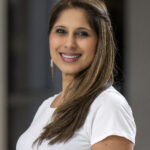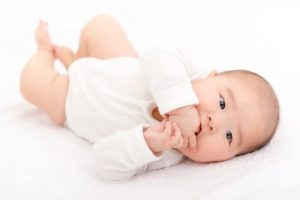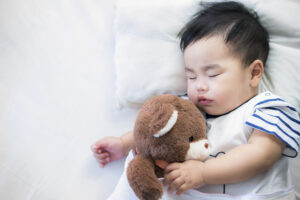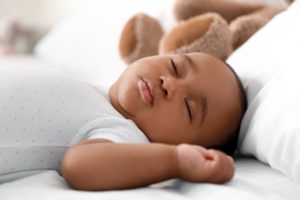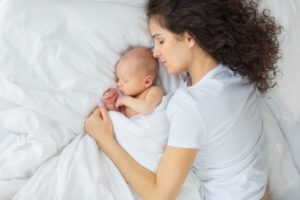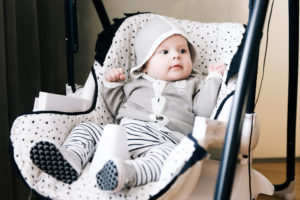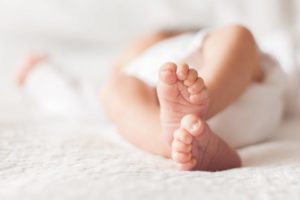When you buy through our links, we may earn a commission. Products or services may be offered by an affiliated entity. Learn more.
Can a Newborn Baby Sleep With a Pacifier?
For many babies, pacifiers provide great comfort, enabling them to satisfy their sucking reflex and self-soothe. Parents may wonder when it is safe for a baby to start sleeping with a pacifier. The answer is that a newborn baby can start sleeping with a pacifier in certain situations.
While bottle-fed babies can sleep with a pacifier from birth, breastfed infants should only sleep with a pacifier once they are at least 3 to 4 weeks old and have settled into a breastfeeding routine with no latching issues.
When Should You Introduce a Pacifier to a Newborn?
Babies may start using pacifiers at different times based on their situation.
Breastfed Babies
For those who plan to breastfeed their babies, the American Academy of Pediatrics (AAP) recommends delaying pacifier use until the baby is at least 3 to 4 weeks old and they have established a routine with breastfeeding. Introducing pacifiers earlier than that may interfere with successful breastfeeding.
Many experts believe a pacifier could lead to nipple confusion , but there is a lack of evidence to support this theory. However, while some recent research suggests that starting a pacifier as early as 2 weeks may be safe as long as your baby has learned to breastfeed successfully , the AAP recommends waiting until your baby is about 1 month old.
There are a few specific situations where pacifiers may be used earlier. For example, a pediatrician may recommend using a pacifier as part of a special program to help a baby develop their oral motor skills. Pacifiers can also provide pain relief during certain medical procedures. It is important to consult your pediatrician or the hospital staff before offering your baby a pacifier for the first time.
Help Your Baby Sleep Better With Pediatric Sleep Coaching

our partner at sleepdoctor.com
Learn More“Life-changing! My anxiety about my son’s sleeping habits were immediately reduced after talking to Sara. She went above and beyond to tailor a schedule to our goals, answer our questions, keep us on track, and check in to encourage us when we just thought we couldn’t do it anymore.”
Rachael B. – Verified Customer
Bottle-Fed Babies
Bottle-fed babies can start using pacifiers at any age, even right after birth. If parents or caregivers decide to offer their babies pacifiers, experts recommend using them every time the baby goes to sleep, including for naps.
Premature Babies
Studies suggest that for premature babies, using a pacifier can speed the transition to oral feeding, which it is important to start as soon as possible to help them grow.
Preterm babies have trouble coordinating sucking, swallowing, and breathing . Until they learn to feed on their own, premature babies generally stay in the neonatal intensive care unit so they can receive food through an oral or nasal tube. Pacifiers may help preterm babies develop their sucking muscles, so they can start feeding by mouth and gain weight faster.
A recent study found that using a pacifier did not negatively affect the transition to breastfeeding, the time to learn to feed, or the length of stay in the hospital. However, babies who practiced sucking on the mother’s emptied breast instead of a pacifier were more likely to breastfeed exclusively when they were discharged from the hospital.
Benefits of Sleeping With a Pacifier
Pacifiers provide newborns with several benefits, particularly during their first 6 months . Pacifiers can calm babies when they are feeling fussy or anxious. They may also relieve pain and ease their crying during medical procedures. Research suggests non-nutritive sucking, such as on a pacifier, may support healthy baby sleep.
Using a pacifier during sleep also appears to significantly lower a baby’s risk of sudden infant death syndrome (SIDS), although researchers still do not understand the specific reason why , or even if the lower risk can be attributed solely to the use of a pacifier. It is possible pacifiers help babies stabilize their breathing and heart rate during sleep. Some researchers have proposed that using a pacifier might decrease the risk of SIDS by keeping the baby somewhat aware during sleep, though more research is needed.
Pacifiers may also help keep the airway open during sleep by pushing the tongue forward. Alternatively, a pacifier may clear more space for breathing around the nose and mouth or help prevent a baby from rolling over onto their stomach, a position known to increase the risk of SIDS.
The protective effect of pacifiers is more pronounced when the baby is in an unsafe sleep environment, such as when they are sleeping on their stomach or their side, sharing their bed with an adult, or have soft bedding in their crib. But even in a safe sleep environment, or if the pacifier falls out , the association between pacifiers and a lower risk of SIDS still holds.
Risks of Sleeping With a Pacifier
Pacifiers may help babies get the sleep they need, but in addition to potentially interfering with breastfeeding, they may contribute to dental issues, ear infections, and oral yeast infections.
Middle ear infections may be more common among babies who use pacifiers, but these are not typically a concern until the baby reaches 12 months old. Researchers have found that part of the increased risk can be attributed to a child entering a daycare environment. By limiting the use of a pacifier to bedtime, parents can reduce the number of middle ear infections.
Pacifier use can also lead to a crossbite, where the upper and lower teeth do not align correctly. However, this problem often goes away once the baby stops using a pacifier, and is unlikely to create long-term issues if the baby stops using a pacifier by the age of 3 years old.
Tips for Safely Introducing a Pacifier to Your Newborn
If you choose to offer your baby a pacifier, follow advice for safe pacifier use:
- Use the right size pacifier for your baby’s age
- Use one-piece pacifiers
- Do not attach anything to the pacifier
- Always use a clean pacifier
- Offer a pacifier at naptime and bedtime
- Do not substitute for feeding
- Do not force it
When Should You Stop Giving Your Baby a Pacifier for Sleep?
Experts offer different guidance about when to wean a baby off their pacifier, but most agree that caregivers should stop offering pacifiers between the ages of 6 months and 4 years.
To prevent dental issues, the American Academy of Pediatric Dentistry recommends eliminating pacifiers once your child is 3 years old. To avoid middle ear infections, the American Academy of Pediatrics and the American Academy of Family Physicians recommend starting to decrease pacifier use between the ages of 6 and 12 months old. To reduce the chance that a pacifier might interfere with learning to talk, some experts recommend stopping pacifier use when a toddler is 14 months old.
Since the age range in which to eliminate the pacifier is so varied among experts, the parent should decide when it is best to eliminate the pacifier based on the benefits it provides, being mindful not to go past the upper recommended age of 4 years.
While pacifiers in early life are useful for strengthening your baby’s sucking reflexes, their importance after 6 months of age lies mainly in the sense of comfort they provide. To ease anxiety as your baby moves on from the pacifier, you can offer age-appropriate alternatives. Younger infants may find comfort in receiving a massage or having a lullaby sung to them. For toddlers, consider playing together or offering words of encouragement. Providing other things for self-soothing, like their blanket, a favorite toy or a stuffed animal can be additionally comforting. Stopping abruptly may also be effective.
When to Talk to Your Pediatrician
As part of routine visits to your pediatrician, ask them about the benefits and drawbacks of using a pacifier and whether they think it is appropriate for your situation. Your pediatrician can also advise you on best practices when using a pacifier and when to eliminate it, as well as alternatives if you decide you prefer not to.
While there is evidence that sleeping with a pacifier is associated with a reduced risk of SIDS, experts maintain that whether or not to use a pacifier is a parent’s personal decision. Healthy sleep is important for babies, and a pacifier may help with that. You can decide based on your needs and what makes you and your baby comfortable.

Still have questions? Ask our community!
Join our Sleep Care Community — a trusted hub of sleep health professionals, product specialists, and people just like you. Whether you need expert sleep advice for your insomnia or you’re searching for the perfect mattress, we’ve got you covered. Get personalized guidance from the experts who know sleep best.
References
9 Sources
-
Zimmerman, E., & Thompson, K. (2015). Clarifying nipple confusion. Journal of Perinatology: Official Journal of the California Perinatal Association, 35(11), 895–899.
https://pubmed.ncbi.nlm.nih.gov/26181720/ -
Lubbe, W., & Ten Ham-Baloyi, W. (2017). When is the use of pacifiers justifiable in the baby-friendly hospital initiative context? A clinician’s guide. BMC Pregnancy and Childbirth, 17(1), 130.
https://pubmed.ncbi.nlm.nih.gov/28449646/ -
Alm, B., Wennergren, G., Möllborg, P., & Lagercrantz, H. (2016). Breastfeeding and dummy use have a protective effect on sudden infant death syndrome. Acta Paediatrica (Oslo, Norway: 1992), 105(1), 31–38.
https://pubmed.ncbi.nlm.nih.gov/26175065/ -
Yildiz, A., & Arikan, D. (2012). The effects of giving pacifiers to premature infants and making them listen to lullabies on their transition period for total oral feeding and sucking success. Journal of Clinical Nursing, 21(5-6), 644–656.
https://pubmed.ncbi.nlm.nih.gov/21668549/ -
Li, L., Wang, L., Niu, C., Liu, C., Lv, T., Ji, F., Yu, L., Yan, W., Dou, Y. L., Wang, Y., Cao, Y., Huang, G., & Hu, X. (2021). Early skin contact combined with mother’s breastfeeding to shorten the process of premature infants ≤ 30 weeks of gestation to achieve full oral feeding: The study protocol of a randomized controlled trial. Trials, 22(1), 637.
https://pubmed.ncbi.nlm.nih.gov/34535164/ -
Fucile, S., Wener, E., & Dow, K. (2021). Enhancing breastfeeding establishment in preterm infants: A randomized clinical trial of two non-nutritive sucking approaches. Early Human Development, 156, 105347.
https://pubmed.ncbi.nlm.nih.gov/33714801/ -
Sexton, S., & Natale, R. (2009). Risks and benefits of pacifiers. American Family Physician, 79(8), 681–685.
https://pubmed.ncbi.nlm.nih.gov/19405412/ -
Psaila, K., Foster, J. P., Pulbrook, N., & Jeffery, H. E. (2017). Infant pacifiers for reduction in risk of sudden infant death syndrome. The Cochrane Database of Systematic Reviews, 4(4), Article CD011147.
https://pubmed.ncbi.nlm.nih.gov/28378502/ -
Task Force on Sudden Infant Death Syndrome, Moon, R. Y., Darnall, R. A., Feldman-Winter, L., Goodstein, M. H., & Hauck, F. R. (2016). SIDS and other sleep-related infant deaths: Updated 2016 recommendations for a safe infant sleeping environment. Pediatrics, 138(5), e20162938., Updated 2016 recommendations for a safe infant sleeping environment. Pediatrics, 138(5), e20162938.
https://pubmed.ncbi.nlm.nih.gov/27940804/

